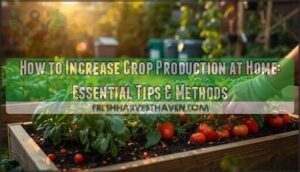This site is supported by our readers. We may earn a commission, at no cost to you, if you purchase through links.

For leaf lettuce, cut outer leaves when they’re 4-6 inches tall, leaving the center to keep growing.
Head lettuce is ready when it forms a firm, compact center—harvest the entire plant by cutting at soil level.
Use a sharp knife or scissors in early morning when leaves are crisp and full of moisture.
Watch for bolting signs like elongated stems or bitter taste, which means you’ve waited too long.
The cut-and-come-again method works best for leaf varieties, giving you multiple harvests from one plant.
There’s actually a sweet spot that doubles your yield if you know when to look.
This approach requires careful observation and timing to achieve the best results with proper harvesting.
Table Of Contents
- Key Takeaways
- Harvesting Lettuce Basics
- How to Harvest Lettuce
- Identifying Maturity Signs
- Harvesting Methods Explained
- Post Harvest Care Tips
- Frequently Asked Questions (FAQs)
- How do you harvest leaf lettuce?
- When to harvest lettuce?
- When should you harvest lettuce leaves?
- How do you pick lettuce?
- How often should you harvest leaf lettuce?
- How to harvest lettuce without compromising its health?
- How do you harvest a lettuce leaf?
- Can lettuce be cooked?
- Should you harvest a whole head of lettuce?
- Should lettuce be dug out before harvesting?
- Conclusion
Key Takeaways
- You’ll get multiple harvests by using the cut-and-come-again method—cut outer leaves at 4-6 inches while leaving the crown intact for continuous regrowth
- Harvest in early morning when leaves are crisp and full of moisture, using sharp, clean scissors to prevent plant damage and disease spread
- Watch for bolting signs like elongated stems or bitter taste, and harvest immediately once you spot them to avoid ruining your crop
- Take only one-third of the plant at each harvest to maintain healthy regrowth and extend your growing season for weeks instead of days
Harvesting Lettuce Basics
You’ll achieve the best lettuce harvests by timing your picking perfectly and using the right techniques.
Perfect timing and clean cuts are the secret to abundant lettuce harvests that keep producing all season long.
Harvest lettuce in early morning when leaves are crisp, using clean scissors to cut outer leaves while leaving the crown intact for continued growth, which allows for the best possible harvests.
Optimal Harvest Time
Timing your lettuce harvest correctly transforms a good crop into an exceptional one. Cool season conditions between 60-70°F create ideal harvest conditions, while growth stages determine when your lettuce reaches peak leaf maturity for maximum lettuce yield.
Knowing the ideal harvest times for different lettuce varieties is essential for best results.
- Harvest leaf lettuce when leaves reach 4-6 inches for best harvest techniques
- Morning harvest time preserves crispness and extends storage life
- Harvest before temperatures exceed 80°F to prevent bitter flavors
- Peak harvesting lettuce occurs 30-70 days after planting depending on variety
Factors Affecting Harvest
Temperature impacts dictate your harvest window more than you’d think.
Hot weather above 80°F triggers bolting prevention challenges, making leaves bitter quickly.
Variety maturity rates differ substantially – quick varieties mature in 30 days while others need 70.
Soil conditions affect growth speed and leaf quality.
Understanding these factors helps you time harvests perfectly using proper harvesting techniques and tools.
Tools and Techniques
Your harvest tools determine success just as much as timing does.
Sharp garden shears or scissors work best for clean cuts, while sanitized tools prevent disease spread between plants.
Choose cutting height carefully—leave one inch at the base for regrowth techniques.
Use a basket for collecting leaves, and maintain proper shear sharpness for efficient harvesting lettuce throughout the growing season.
Proper garden shear maintenance is essential for a healthy harvest, and it involves using sharp tools to prevent disease spread.
How to Harvest Lettuce
Once you’ve determined your lettuce is ready, the actual harvesting process becomes your gateway to garden-fresh meals.
Different lettuce varieties require specific approaches to maximize both immediate yield and future production potential.
Here’s your step-by-step harvesting lettuce guide:
- Choose morning hours – Harvest timing matters for crispness and flavor retention
- Use sharp garden tools – Clean scissors or shears prevent plant damage and disease
- Start with outer leaves – Leaf removal begins with the largest, most mature growth
- Leave the crown intact – This guarantees successful cut and come again lettuce production
- Take only one-third – Loose leaf lettuce needs remaining foliage for continued energy production
For loose leaf lettuce, you’ll snip individual leaves at their base, leaving about an inch of stem.
Head varieties like romaine require cutting the entire head when firm.
The cut and come again method works best with leaf types, allowing multiple lettuce harvest cycles throughout the season.
Clean your garden tools between plants to prevent disease spread.
Understanding fall harvesting techniques is vital for maintaining the health and productivity of your lettuce plants.
Identifying Maturity Signs
You can easily tell when lettuce is ready to harvest by checking specific visual and physical cues for each variety.
Different lettuce types mature at different rates, and recognizing these signs guarantees you pick at peak flavor while avoiding bitter, bolted plants, which is crucial for peak flavor and to prevent bitter taste.
Leaf Lettuce Maturity
Leaf lettuce reaches peak harvest when outer leaves measure 4-6 inches long with vibrant color and tender texture.
Look for loose, open lettuce growth without dense heads – these maturity signs indicate ideal leaf size for harvesting lettuce leaves.
Baby greens can be picked at 25 days, while full maturity occurs in 30-60 days depending on lettuce growth stages and regrowth techniques used.
For optimal results, consider the proper harvest techniques to maximize yield and flavor with proper techniques and optimal results.
Head Lettuce Maturity
Unlike their loose-leaf cousins, head lettuce varieties like romaine, butterhead, and crisphead require different maturation signs for ideal harvesting lettuce timing.
You’ll know your head lettuce has reached proper lettuce maturity when these key indicators appear:
- Firm squeeze test – Gently press the center; mature heads feel solid and compact rather than soft or spongy
- Full head formation – The lettuce growth creates a dense, well-formed head with tightly packed leaves showing proper leaf texture
- Size completion – Crisphead reaches 6+ inches diameter while butterhead forms loose but substantial heads ready for lettuce harvesting
Understanding fall harvest techniques is vital for maximizing yield and flavor.
Signs of Bolting
When checking for bolting prevention failure, watch for sudden upward growth that transforms your compact lettuce into a leggy tower.
The central stem shoots skyward overnight, spacing leaves farther apart while developing a bitter taste.
Flowering stems emerge next, signaling the end of quality harvest time.
Once you spot seed formation beginning, harvest immediately—crisphead varieties show thickened centers before flowering takes over completely, which is a sign of the end of the quality harvest time.
Harvesting Methods Explained
You’ll need to choose the right harvesting method based on your lettuce type and growing goals. Each technique offers different benefits for yield, flavor, and regrowth potential.
Cut and Come Again Method
The cut and come again method transforms your lettuce harvesting approach by targeting only outer leaves while preserving the growing crown.
You’ll harvest by cutting 1-2 inches above the base, removing just one-third of leaves at once. This continuous harvesting technique enables 8-10 harvests per plant, multiplying your loose leaf lettuce yield sixfold compared to single cuts.
Sharp scissors guarantee clean leaf removal without damaging regrowth tips. Effective lettuce harvesting often involves using the right harvest tool equipment to make the process more efficient.
Single Harvest Method
The single harvest method involves uprooting the entire lettuce plant when it reaches full maturity.
This harvesting lettuce technique works best for head varieties like iceberg and romaine that form tight, compact centers.
- Harvest timing – Wait until heads feel firm when gently squeezed
- Digging tools – Use a sharp knife or garden shears for stem cutting
- Plant uprooting – Cut at soil level or dig up the complete root system
- Leaf removal – Strip away damaged or loose outer leaves before storage
- Final check – Rinse thoroughly and inspect for quality before consuming
To maximize yield and prevent spoilage, it’s vital to follow proper post harvest handling techniques.
Preventing Bolting
Bolting Prevention keeps your lettuce harvest going strong.
Temperature spikes above 80°F trigger early flowering, ruining taste and texture.
Smart timing beats the heat every time.
| Prevention Strategy | Application Method |
|---|---|
| Heat Control | Use shade cloth during hot afternoons |
| Water Regulation | Maintain consistent deep watering |
| Succession Sowing | Plant new crops every 2 weeks |
Loose leaf varieties handle stress better than head types.
Crop rotation prevents soil depletion while proper soil management maintains cool root zones.
Post Harvest Care Tips
Once you’ve harvested your lettuce, proper post-harvest care determines how long it stays fresh and flavorful.
The right cleaning, storage, and handling techniques can extend your lettuce’s shelf life from days to weeks.
Cleaning and Storing Lettuce
Properly cleaning your freshly harvested lettuce guarantees maximum freshness and safety. Start with the cold bath soak method for thorough dirt removal, then dry carefully to preserve crispness.
Here’s your step-by-step lettuce washing and storage process:
- Separate leaves and soak in cool water for 10 minutes to remove dirt and grit
- Add vinegar solution (¼ cup white vinegar per 10 cups water) for 2-minute bacteria removal
- Spin dry gently using a salad spinner or roll in clean towels
- Store in airtight containers lined with dry paper towels for water retention
- Refrigerate immediately at 32°F to maintain crispness and extend shelf life
Understanding key harvest fresh techniques is vital for achieving the best results in lettuce harvesting and storage.
Maintaining Lettuce Freshness
After proper cleaning, maintaining peak freshness requires smart lettuce storage techniques.
Store your harvested greens in the refrigerator’s crisper drawer with humidity control set to high. Wrap leaves in damp paper towels for water retention, then place in perforated plastic bags.
This method preserves crispness for up to ten days. Check daily and remove any wilted leaves to prevent spoilage from spreading throughout your freshness preservation system.
Using proper lettuce storage methods can substantially extend the shelf life of your lettuce, and help with lettuce storage.
Regrowing Lettuce
Beyond keeping your lettuce fresh, you can actually regrow new leaves from harvest scraps. This lettuce regrowth technique turns kitchen waste into fresh greens through simple stem cutting and plant rejuvenation methods.
- Cut romaine stem base 1-2 inches from bottom
- Place in shallow water, changing every 2 days
- Expect new leaf renewal within 3-5 days
- Transplant rooted stumps to soil for bigger yields
This harvest cycling approach works best with romaine varieties, offering multiple rounds of lettuce regeneration from a single purchase.
Frequently Asked Questions (FAQs)
How do you harvest leaf lettuce?
Unlike harvesting head lettuce which requires waiting for full maturity, you can harvest leaf lettuce continuously. Cut outer leaves at 4-6 inches long, leaving inner growth intact for ongoing production.
When to harvest lettuce?
Harvest lettuce when outer leaves reach 4-6 inches long, typically 30-40 days after planting. Pick in early morning for crispness. Cut before temperatures hit 80°F to prevent bitter bolting.
When should you harvest lettuce leaves?
You’ll want to start picking lettuce leaves when they reach 4-6 inches long, typically 30-40 days after planting. Harvest in early morning for maximum crispness and sweetness.
How do you pick lettuce?
Like streaming Netflix in the 1800s, you’ll want sharp scissors for clean cuts.
Snip outer leaves at the base, leaving about an inch of stem.
Pick the biggest leaves first, taking only one-third of each plant to keep it growing strong.
How often should you harvest leaf lettuce?
You can harvest leaf lettuce every few days once it has at least six leaves.
Cut the outer leaves when they’re 4-6 inches long, taking about one-third of the plant each time for continuous regrowth.
How to harvest lettuce without compromising its health?
Cut outer leaves at the stem base, leaving inner growth intact.
Use sharp, clean scissors and harvest only one-third of the plant at once.
This cut-and-come-again method maintains healthy regrowth for continuous production.
How do you harvest a lettuce leaf?
Gently pinch or cut the outer leaf at its base using clean scissors, leaving about one inch of stem attached to the plant’s crown for continued regrowth.
Can lettuce be cooked?
Yes, you can absolutely cook lettuce.
While it’s typically eaten raw, lettuce works well sautéed, grilled, braised, or added to soups and stir-fries.
Cooking transforms its texture and creates a mild, slightly sweet flavor that’s surprisingly delicious.
Should you harvest a whole head of lettuce?
You’ll get better results harvesting outer leaves continuously rather than cutting the whole head.
This "cut-and-come-again" method keeps your plant producing for weeks instead of ending its life cycle with one harvest.
Should lettuce be dug out before harvesting?
Most lettuce varieties don’t require digging up before harvest. You’ll cut individual leaves or whole heads at soil level, leaving roots intact for potential regrowth with leaf varieties.
Conclusion
Mastering how to harvest lettuce properly transforms your garden from a one-time crop into a continuous food source.
You’ve learned that timing beats everything—catching leaf lettuce at 4-6 inches while leaving the crown intact, or waiting for head lettuce’s firm center before cutting at soil level.
The cut-and-come-again method maximizes your yield, while morning harvests guarantee peak crispness.
With sharp tools and careful observation, you’ll avoid bolting and enjoy fresh lettuce for months, using the cut-and-come-again method to ensure a lasting supply.
- https://www.attainable-sustainable.net/know-how-harvesting-lettuce/
- https://www.gardenary.com/blog/how-to-harvest-lettuce-to-increase-production
- https://seedsavers.org/grow-lettuce/
- https://www.homedepot.com/c/ah/how-to-harvest-lettuce/9ba683603be9fa5395fab90159a87ec3
- https://www.reddit.com/r/gardening/comments/1dh72ws/whats_the_best_way_to_harvest_lettuces_on_an/



